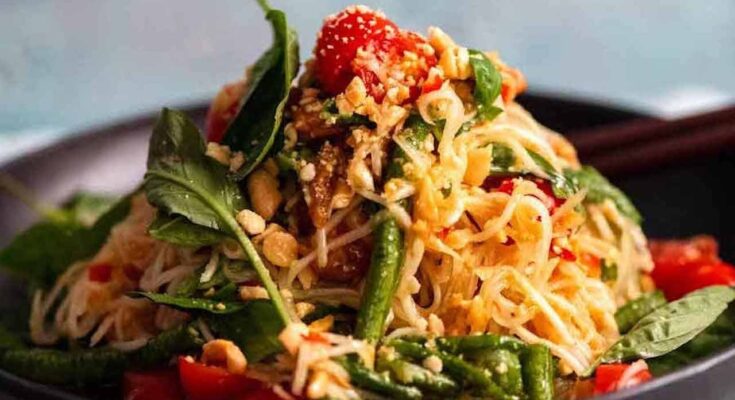Papaya Salad Recipe: Papaya Salad, also known as Som Tum, is a fiery, tangy, and slightly sweet Thai delicacy that has found its way into kitchens around the world. Made from crisp shredded green papaya, crushed garlic, spicy chilies, and a flavorful dressing of lime juice and fish sauce, this dish packs a powerful punch. It’s not just a salad—it’s an experience. You feel the crunch, the zest, the spice, and the refreshing coolness in every bite. This dish is especially popular in Thailand, Laos, and parts of Cambodia, and each region adds its own twist.
Som Tum’s roots lie in the countryside kitchens of Thailand, where it was often prepared with a mortar and pestle to meld the flavors together. The beauty of papaya salad is its versatility. Whether you love it spicy or mild, with peanuts or dried shrimp, you can tweak it to suit your taste.
Why You’ll Love This Zesty Delight
Papaya salad is not just delicious—it’s incredibly healthy too. It’s low in calories, high in fiber, and loaded with vitamins A and C. Plus, it’s gluten-free and can easily be made vegetarian or vegan. For those looking to enjoy something light, tangy, and packed with flavor, papaya salad is the perfect choice. The fresh crunch of papaya, the kick from chilies, and the brightness of lime create a dance of flavors in your mouth. Plus, it’s a quick dish—you can whip it up in under 20 minutes once you’ve got all your ingredients ready.
Ingredients You’ll Need
Fresh Produce and Herbs
The star of the show here is green papaya. Unlike ripe papaya, green papaya is firm and has a neutral flavor, making it ideal for soaking up the tangy, spicy dressing. You’ll also need:
- 1 medium green papaya (peeled and shredded)
- 1-2 cloves garlic
- 1-2 Thai bird’s eye chilies (adjust for spice)
- 1 small carrot (optional, for color and crunch)
- A handful of cherry tomatoes, halved
- Fresh lime juice (from 2 limes)
- A handful of fresh cilantro (optional)
Sauces and Seasonings
The dressing is what makes or breaks your papaya salad. Here’s what you need:
- 2 tablespoons fish sauce (or soy sauce for vegan option)
- 1 tablespoon palm sugar (or brown sugar)
- 2 tablespoons lime juice
- 1 tablespoon tamarind paste (optional, adds depth)
- Crushed peanuts (for topping)
- Salt to taste
Optional Add-Ons for Extra Flavor
Want to take it up a notch? Add:
- Dried shrimp (for authentic Thai flavor)
- String beans or long beans, cut into 2-inch pieces
- Grated green mango for extra tang
- Crushed chili flakes for more heat
These additions enhance the complexity and richness of the salad. If you like experimenting, you can even top it with grilled prawns or tofu for a protein-packed variation.
Equipment Required
Traditional Tools vs Modern Substitutes
In traditional Thai kitchens, Som Tum is made using a mortar and pestle (called a “pok pok”). This tool helps to lightly bruise the ingredients, releasing their flavors and blending them beautifully. However, don’t worry if you don’t own one. Here’s what you can use:
- Mortar and Pestle: Best for mashing chilies, garlic, and blending flavors.
- Vegetable Peeler and Julienne Peeler: To shred the green papaya finely.
- Mixing Bowl and Spoon: For combining everything if you’re skipping the mortar.
- Cutting Board and Knife: For prepping ingredients.
The goal is to lightly crush and mix, not pulverize, so even if you’re using a mixing bowl, use the back of a spoon to gently press the ingredients.
How to Choose the Perfect Green Papaya
Tips for Picking the Right One
Green papayas can be a bit elusive depending on where you live, but most Asian grocery stores carry them. Here’s what to look for:
- Firm to the touch (like a cucumber)
- Deep green skin with no soft spots
- Avoid yellowing or ripening on the skin
- Should feel heavy for its size
If you’re lucky enough to live near a tropical produce market, ask for unripe or green papayas specifically used for salads.
Alternatives if You Can’t Find Green Papaya
If you’re out of luck and can’t find green papaya, don’t worry. You can substitute with:
- Shredded green mango (adds a tangier taste)
- Shredded cucumber (for a crunchier, watery texture)
- Zucchini or jicama (neutral in flavor but gives a similar mouthfeel)
These substitutes still let you enjoy the signature flavors of papaya salad, even if they alter the taste slightly.
Step-by-Step Guide to Making Papaya Salad
Step 1: Peel and Shred the Green Papaya
Start with the most important step—prepping the green papaya. First, wash it thoroughly under running water. Using a sharp vegetable peeler, remove the skin. Be careful—green papaya is quite firm and slippery. Once peeled, cut the papaya in half lengthwise and scoop out the white seeds if present.
Now comes the shredding. Traditionally, Thai cooks hold the papaya and rapidly whack it with a knife, creating fine strips. If that feels a bit too daring, you can use a julienne peeler or a mandoline slicer. The goal is to get long, thin, noodle-like shreds that will soak up all the tangy dressing and maintain a nice crunch.
After shredding, place the papaya in a large bowl of ice water for about 10 minutes. This step helps maintain its crispness. Drain and pat dry before mixing it with other ingredients.
Step 2: Prepare the Dressing
The dressing is the soul of your papaya salad. It’s a balanced dance of sweet, sour, salty, and spicy flavors. In a mortar, pound garlic and chilies together until crushed. This releases their oils and kicks up the flavor.
Add fish sauce, lime juice, and palm sugar to the mix. If you’re using tamarind paste, throw that in as well. Keep pounding gently until the sugar dissolves. You should taste as you go—some like it saltier, others sweeter. Adjust to suit your taste buds.
If you don’t have a mortar, mix the ingredients in a bowl using the back of a spoon to crush the garlic and chilies. You want everything well-combined and slightly emulsified.
This dressing is what ties everything together, seeping into the papaya shreds and creating a flavor explosion in every bite.
Step 3: Mix and Mash for Flavor
Now it’s time to combine everything. Place the shredded papaya, cherry tomatoes, and optional carrot slices into the mortar (or a large mixing bowl). If using string beans, add those too.
Pour the dressing over the ingredients. Use the pestle to lightly pound and a spoon to toss. This step is crucial—bruising the papaya slightly helps it absorb the dressing better. You’re not pulverizing here; think of it like coaxing the flavors into each other.
Mix until everything is coated and slightly wilted. Taste again and adjust with more lime juice or fish sauce if needed.
If using a bowl, press down gently with the back of a spoon while stirring to simulate the mortar’s pressure. It won’t be quite the same, but it’ll do the trick.
Step 4: Toss and Taste
Give the salad one final toss to ensure all the ingredients are well mixed. The colors should be vibrant—green papaya, red tomatoes, orange carrots, and maybe a few green beans peeking through.
Now taste. Is it tangy enough? Too spicy? This is your chance to tweak it. Add a pinch more sugar if it’s too sour, a dash more fish sauce if it needs salt, or another chili if you like it hotter.
At this point, the papaya should have absorbed the dressing, softening slightly while retaining its signature crunch. The tomatoes will be juicy, the garlic aromatic, and every bite bursting with complexity.
This is also the time to mix in any final toppings—dried shrimp, extra peanuts, or even a handful of chopped cilantro for a herby finish.
Step 5: Garnish and Serve
Presentation makes a big difference. Scoop the salad into a shallow dish or bowl. Sprinkle crushed peanuts generously over the top. If you’re going the traditional route, top with a few dried shrimp and a wedge of lime on the side.
For a beautiful finish, you can garnish with extra chili slices, julienned carrots, or even edible flowers if you want to get fancy.
Serve immediately. Papaya salad is best enjoyed fresh when the textures are crisp, and the flavors are bold. If you’re pairing it with other dishes, it goes great with sticky rice, grilled meats, or tofu. It also makes a stellar appetizer or light main course on its own.
Variations of Papaya Salad
Regional Twists Across Southeast Asia
Papaya salad isn’t just a Thai thing. Different countries across Southeast Asia have embraced it and added their own unique flair. In Laos, for example, it’s called Tam Mak Hoong. This version is often funkier and more fermented, using fermented fish sauce called padek. The flavors are deeper and more intense, appealing to those who enjoy bold, umami-rich profiles.
In Cambodia, it’s known as Bok Lahong, often made with crab and sometimes garnished with crushed raw eggplant. Cambodian versions also tend to lean more savory and are served alongside grilled meats.
Vietnamese styles of papaya salad often use shredded green papaya as a bed for dried beef or seafood, combined with fish sauce dressing and roasted peanuts. These versions may be less spicy but still burst with flavor and texture.
Each regional version tells a story—of local ingredients, cultural preferences, and culinary creativity. Trying them all is like going on a delicious journey across borders.
Protein-Packed Papaya Salad Options
Want to make your salad a bit more filling? You can easily add protein to turn this light dish into a satisfying meal. Here are some ideas:
- Grilled Shrimp or Prawns: Adds a smoky, savory note that pairs beautifully with the tart dressing.
- Grilled Chicken: Perfect for those looking for lean protein; marinate in garlic and soy for extra flavor.
- Tofu or Tempeh: For vegetarian or vegan eaters, marinated and grilled tofu provides great texture and protein.
- Boiled Eggs: Halved and served on the side or chopped into the salad.
These additions don’t just bulk up the dish—they bring new textures and layers to the flavor profile. Just make sure any added protein complements rather than overpowers the papaya.
Serving Suggestions
Perfect Pairings for Your Papaya Salad
Som Tum is versatile. While it’s incredible on its own, pairing it with the right sides elevates your meal. In Thailand, it’s commonly served with sticky rice—a slightly sweet, chewy contrast to the spicy salad. You tear off pieces with your fingers and use it to scoop up the salad. It’s rustic and fun.
Other great pairings include:
- Grilled meats like Thai-style chicken or pork skewers.
- Lettuce wraps with bits of papaya salad and a dash of soy sauce.
- Coconut rice to balance the spice with sweetness.
Serve with a cool drink—think Thai iced tea or coconut water—to help soothe the heat from the chilies. The freshness of the salad makes it perfect for warm days and sunny gatherings.
Storage and Make-Ahead Tips
Keeping It Fresh and Flavorful
Papaya salad is best eaten fresh, but sometimes you want to prep ahead. Here’s how to store it without sacrificing texture:
- Keep the dressing separate. Shred the papaya and store it in an airtight container in the fridge. It stays crisp for up to 3 days.
- Mix when ready to serve. Combine the ingredients just before eating so the papaya doesn’t get soggy.
- If already dressed, store in the fridge and consume within 24 hours. The salad will be softer, but the flavor will still be punchy.
You can also make the dressing in bulk and keep it in a sealed jar in the fridge for up to a week. It makes throwing together a quick salad super easy.
Common Mistakes to Avoid
Tips for Getting It Right Every Time
Even the simplest dishes can go sideways. Here’s what to watch out for:
- Using ripe papaya: Green papaya is firm and neutral. Ripe papaya is sweet and mushy—not what you want here.
- Skipping the pounding or tossing step: This helps blend the flavors. Don’t just pour the dressing on and call it done.
- Overdressing the salad: The papaya should be coated, not drowning. Add dressing slowly and taste as you go.
- Not adjusting to taste: The balance of salty, sweet, sour, and spicy should suit your palate. Use your tongue, not just the recipe.
Making Som Tum is part recipe, part intuition. The more you make it, the better you’ll get at understanding how each ingredient plays with the others.
FAQs about Papaya Salad Recipe
1. Can I make papaya salad ahead of time?
Yes, but keep the shredded papaya and dressing separate until serving to maintain the crunch.
2. What can I use instead of green papaya?
Shredded green mango, zucchini, cucumber, or jicama can work as substitutes.
3. Is papaya salad vegan-friendly?
It can be! Use soy sauce instead of fish sauce and skip the dried shrimp for a plant-based version.
4. How spicy is papaya salad?
That’s up to you. You can make it mild with one chili or fiery with several. Adjust to your preference.
5. Can I add other vegetables?
Absolutely. Carrots, long beans, cabbage, and even radish can be delicious additions.
Conclusion
Papaya salad, or Som Tum, is a celebration of bold flavors, fresh ingredients, and simple techniques. It’s a dish that invites creativity, experimentation, and personal flair. Whether you’re making the traditional Thai version or putting your own spin on it with proteins and local produce, the result is always something vibrant and delicious.
From the crunch of the green papaya to the tang of lime and the fiery kick of chilies, every bite delivers a burst of flavor. And the best part? It’s as fun to make as it is to eat. So next time you’re craving something fresh, zesty, and satisfying—whip up a bowl of papaya salad. Trust me, your taste buds will thank you.



